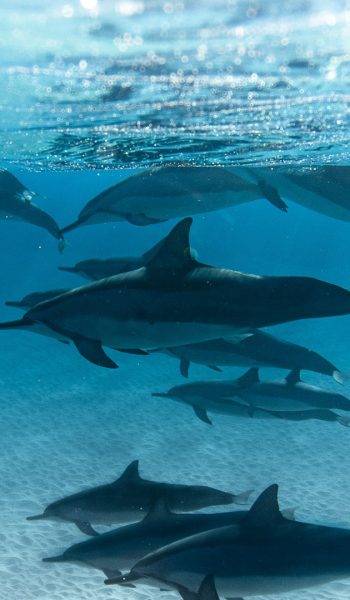In the ocean, many marine mammals and other species rely on their hearing for survival. Sound is critical for communication, navigation, locating prey, avoiding
predators and finding mates.
Ocean noise from ships and other human activity is increasingly impacting our marine life. We consider the effects of underwater noise pollution; and suggest some
solutions.
Understanding the impact of underwater noise pollution
The world’s oceans are a complex ecosystem and home to at least 230,000 different marine species: marine mammals (for example whales and dolphins), fish, shellfish, invertebrates, sharks, turtles and seabirds.
Mammals and marine life depend upon sound for communication and survival underwater. Sound itself is not the critical issue however: the problem arises when sounds turn into “noise.” The degree of the problem depends on each species’ sensitivity threshold and on the type of impact generated (e.g. disturbances, avoidance, damage).
There is now increasing evidence that human activities – known as anthropogenically generated sounds – are having a significant acoustic impact. Sound also travels much faster in water than in air, accentuating the problem of noise pollution. The biodiversity of the ocean is threatened by underwater noise pollution, especially from ships and other vessels, fishing boats, military activities, oil rigs and seismic surveys. Commercial shipping is a case in point: shipping noise interacts with sounds made by many species of whales across a broad range of frequencies, and particularly with the 20-500 Hz vocalization range of large baleen whales. The growth in size and volume of commercial shipping fleets will further exacerbate the issue.
Interest and awareness of noise pollution and its impacts has developed particularly over the last 30 years, resulting in research in a number of academic journals and publications. The study of the impacts of underwater noise pollution centers on a range of effects, such as:
- Changes in behaviors:
- Communication between individual marine species underwater
- Schooling behavior
- Feeding
- Avoidance of predators
- Physiology: stress in mammals and other species, seabed vibration
- Identification of suitable habitats
- Reduction in marine populations & breeding habits
- Injury and death
However, noise pollution impacts not only on marine behavior; it can also affect the human food chain. A study published in 2018 concluded that some commercial catches dropped by up to 80% due to noise, with larger fish leaving the area. The acoustic effects also increased bycatches whilst abundance decreased with noise.
Your environmental monitoring at your fingertips!
Optimize your environmental monitoring, become smarter and more sustainable with a unified system that gathers all your environmental sensors & data in one place.

Underwater noise pollution effects: key findings
We will now look into the different acoustic impacts
of underwater noise pollution in more detail, using selected research studies
as examples.
1. Changes in behaviors of mammals underwater
There is considerable evidence to suggest that anthropogenic sounds impacts on marine mammals’ behavior underwater, whether to a small extent or significantly. Such behaviors include diving, surfacing, vocalizing, feeding, and/or mating.
A 2016 study is just one example. The research found evidence for ship noise impacts on humpback whale foraging behavior in the North Atlantic coastal waters. The research study collected data from ten foraging whales using non-invasive archival tags; this simultaneously recorded underwater movements and the acoustic environment of the whale. The study concluded that humpback whales on Stellwagen Bank, an area with chronically elevated levels of shipping traffic, significantly changed their foraging activity when exposed to elevated levels of ship noise.
2. Impacts on reproduction, breeding and population
Acoustic communication often plays a crucial role in reproductive interactions of marine life.
Over eight hundred species of fish have been found to communicate acoustically. A 2017 study considered whether noise affected acoustic communication and subsequent spawning success in fish.
The research studied males of two species of marine fish who were exposed to continuous additional noise. The study found evidence of less acoustic courtship in both species and a reduction of visual courtship in one species. Furthermore, exposed males were less likely to spawn successfully.
3. Injury and mortality
Ocean noise pollution has the potential to induce temporary hearing loss if it is loud or long enough in duration. Research from a 2006 study found that temporary and permanent hearing loss in marine mammals resulted in a reduction in foraging efficiency, reproductive potential, social cohesion and ability to detect predators.
One of the most graphic illustrations of underwater noise pollution in the ocean are the stranding of whales and dolphins, sometimes due to naval sonar activity. These activities can consequently result in vascular damage on the brain, lungs and other organs of these mammals.
In September 2020 450 pilot whales were stranded on the west coast of Tasmania. This was the largest number of whales stranded in Australia’s history. Rescuers saved 108 of the whales with the remainder of the mammals euthanized.
Reducing the impact of underwater noise pollution
An important study published in 2021 by Duarte et al The soundscape of the Anthropocene ocean reviewed the impacts of ocean noise pollution – and proposed solutions to create well-managed soundscapes in a future, healthy ocean.
The authors’ proposals include changing the design of ships and other vessels including ships’ engines and putting a bubble around a windfarm construction site during the pile driving stage.
Passive acoustic monitoring – that is the surveying and observing of acoustic impacts using AI, algorithms and other digital technologies – is another part of the solution towards reducing underwater noise pollution. Using acoustic sensors valuable data can be gathered; this can help to monitor and predict levels of harmful underwater noise pollution, enabling authorities to take appropriate action.
Conclusion
The impacts of anthropogenic noise pollution in marine mammals and other species are diverse – and increasing in their significance and magnitude.
Ocean noise can dramatically alter an animal’s behavior: driving marine life from their habitats, impairing their communication and consequently their ability to feed, reproduce and avoid predators. Sometimes, it can result in injury or even death.
Underwater noise pollution is a major issue: nevertheless, we can do something about it by changing the way we design ships and other vessels. Together, humanity can reduce the volume of anthropogenic noise pollution in our oceans.
Frequently Asked Questions About Underwater Noise Pollution
Underwater noise is bad because it harms marine animals by preventing them from hearing natural ocean noises, pushing them away from their natural habitat, and even changing their migration patterns. This in turn impacts the ocean environment and natural ecosystem.
Human activities such as shipping, sonars, construction activities such as dredging, platforms, drilling and installing oil rig platforms, as well as seismic surveys contribute to underwater noise pollution.
Underwater noise pollution can be prevented with innovative technologies and Artificial Intelligence, such as the Sea Life Module on the Sinay IT platform, the Sinay Hub.





